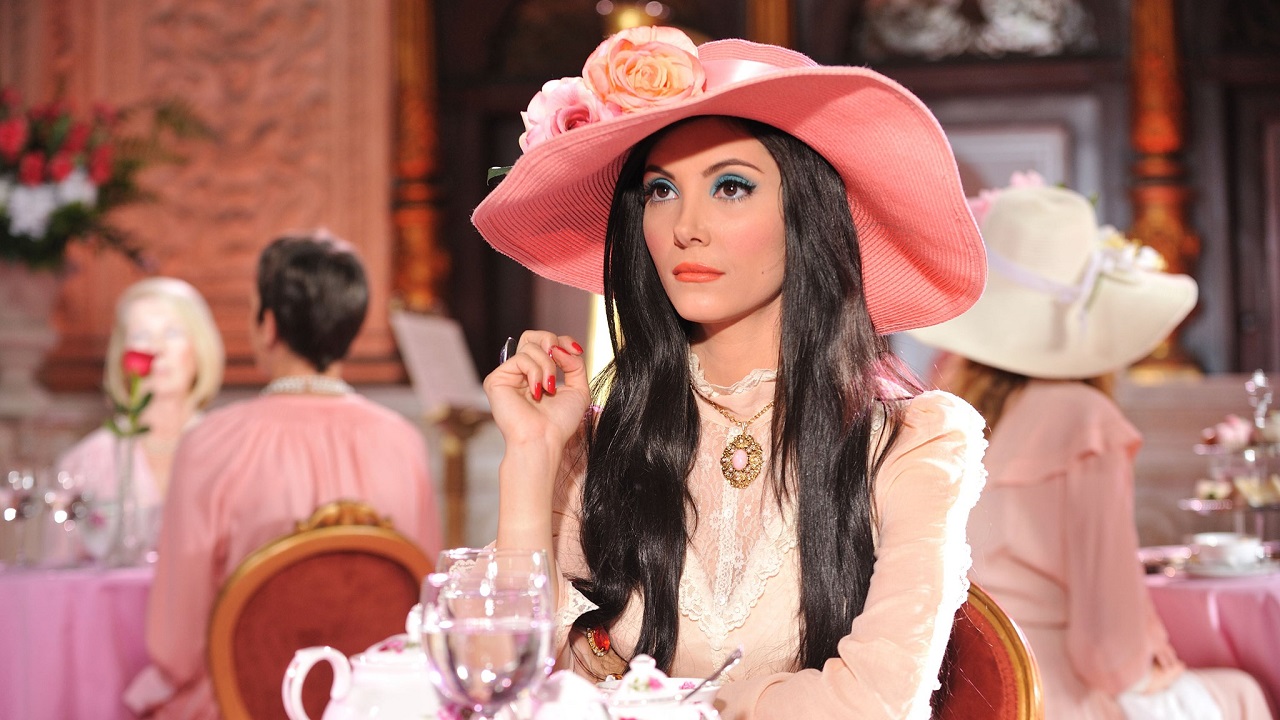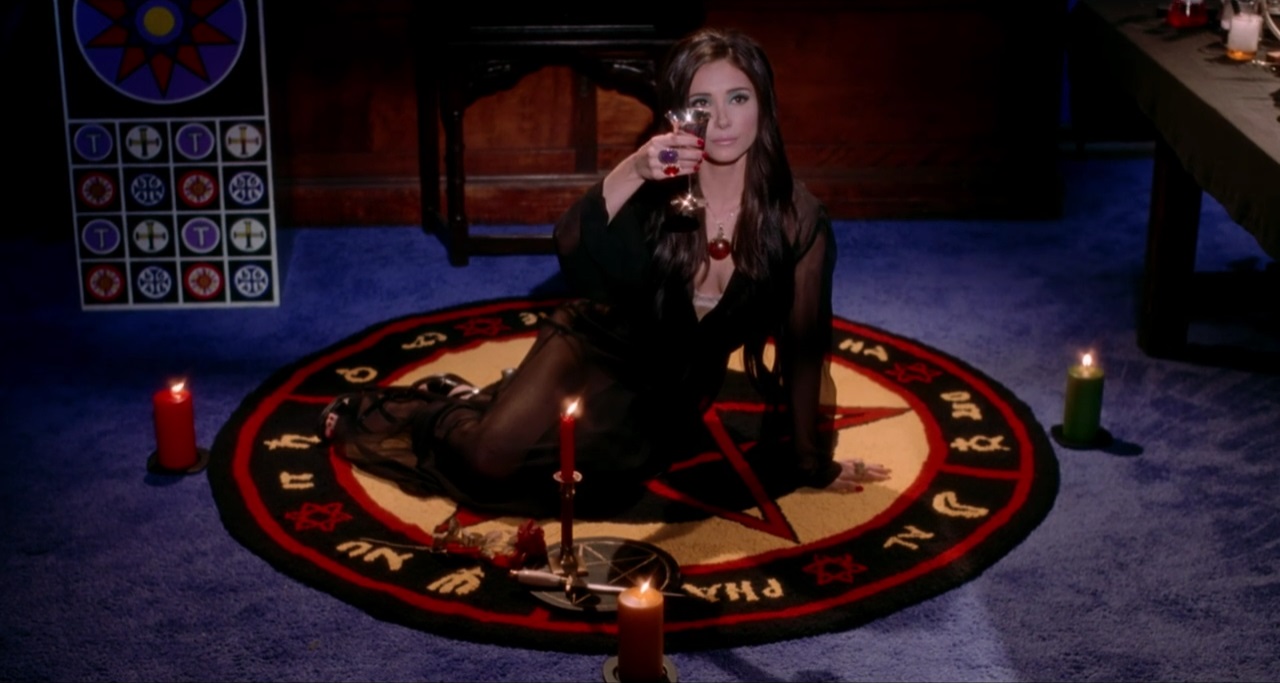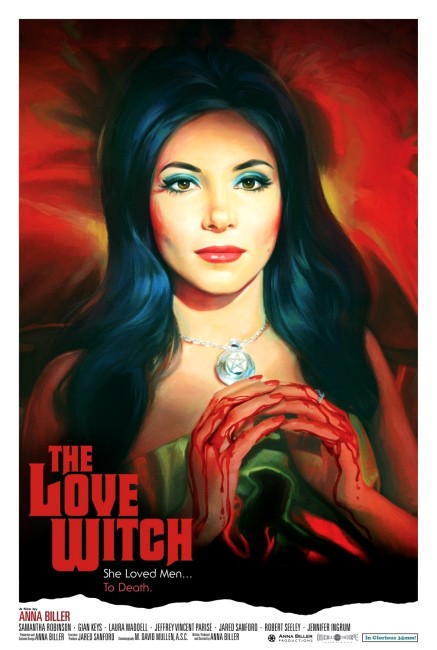Crew
Director/Screenplay/Producer/Music/Production Design – Anna Biller, Photography – M. David Mullen. Production Company – Anna Biller Productions
Cast
Samantha Robinson (Elaine Parks), Gian Keys (Sergeant Griff Meadows), Jeffrey Vincent Parise (Wayne Peters), Robert Seeley (Richard), Laura Waddell (Trish), Randy Evans (Steve), Jennifer Couch (Wendy), Stephen Wozniak (Jerry), Jared Sanford (Gahan)
Plot
Elaine Parks moves to a small town following the death of her husband Jerry. She is a firm believer in love and claims to be addicted to it. She is also a practicing witch. Using her charms, she entices Wayne Peters, taking him away to his cabin in the woods and afterwards leaving him overwhelmed and reduced to uncontrollable tears. She buries his body in the woods and then sets her attentions on the married Richard, driving him to obsessed lust and eventual suicide. When the detective Griff Meadows comes investigating Wayne’s disappearance, Elaine decides that he is her ideal man.
The Love Witch is the fourth film from Anna Biller who had previously made the likes of Three Examples of Myself as Queen (1994), The Hypnotist (2001) and Viva (2007). Anna Biller is a one-woman band. She not only directs, writes and produces her films but (as here) also edits, composes the music and does the production design and costumes, while in previous works she has also acted on screen too. All of her films are lushly shot and designed works that homage the style of different eras.
The moment you start watching The Love Witch, you are overwhelmed by Anna Biller’s visuals. It looks like no other modern film or indeed any film you have seen in the last few years. It has been shot on 35mm and in a way that is designed to resemble the richness of 1950s and 1960s Technicolor films – a look that has almost entirely vanished off screens in the digitally-shot era. The colours of the film leap off the screen at you – perhaps none more so than the scene where Samantha Robinson and Laura Waddell go to a tea rooms where their floridly over-elaborated costumes, those of the other patrons and the entire cafe are all colour coordinated in pink like something that has stepped right out of The Stepford Wives (1975).
The attention paid to the synthesis of look, costuming and sets has a stunning precision. The interior decorations, Samantha Robinson’s hair and costumes all look like they would have been considered the height of fashion circa 1969. You are reminded of the lush women’s fantasies of Douglas Sirk or some of the better works of Jess Franco or Jean Rollin. Although perhaps the only film that approaches such a vibrant visual aesthetic is Harry Kumel’s lusciously strange Malpertuis (1972).

This is also a film that takes its witchcraft very seriously. When there are rituals and paraphernalia on screen, you get the sense that Anna Biller has gone to consult practitioners and made sure that what is depicted on the screen looks authentic. In the film’s heady tie of feminism, witchcraft and the war of the sexes, you are reminded of the far more unserious The Witches of Eastwick (1987), albeit with more of an emphasis on the ‘witch’ aspect. Or perhaps George Romero’s forgotten Jack’s Wife/Season of the Witch/Hungry Wives (1972) having taken its feminist dialectic further than it did.
Anna Biller’s website proudly proclaims that she makes “fabulous films about men, women and love.’ Biller has a great many thing to say about the way that men and women relate together, the nature of love, the dynamics of sexuality, objectification and many associated issues – and none of them in less than completely fascinating ways. The film overspills with internal monologues, discussions and provocative pieces of dialogue. I am still trying to digest them a few days later.
In Biller’s own description, Samantha Robinson represents a woman who has become a constructed artifice: “The film combines my cinematic fantasies … with fragments of emotional pain and desire from my own life and that of other women I’ve known. My hope is that other women will identify with Elaine as I do: as a woman seeking love, who is driven mad by never really being loved for who she is, but only for the male fantasies she has been brainwashed to fulfill.” Biller also talks about creating films that act as mirror, that are in essence her trying on roles of glamour and attractiveness and holding up a mirror to see how they look.

If one is to criticise The Love Witch – and I don’t wish to because I loved it – it would be that the film is more of a very personal essay on the nature of men-woman relations than a dramatic work. The police investigation plot and Samantha Robinson’s trail of victims often gets sidetracks by the need to make another point. Some scenes like the side trip to a mediaeval fair take the film off in a completely different direction for several minutes.
You also reach the end of the film never entirely sure if the views espoused by the central character are ones that represent the view of the writer and you are meant to regard them as statements about the world or they are intended as the utterances of a pathological character. Robinson projects a beguiling and incredibly playful presence on screen – Elaine is a character that manages an ambitious stride in both managing to represent a women’s empowerment fantasy and a femme fatale at the same time. None of which detracts from The Love Witch – it is that rarity of a film that you can repeatedly return to and find something new to take away each time.
(Winner in this site’s Top 10 Films of 2016 list. Nominee for Best Actress (Samantha Robinson) and Best Cinematography at this site’s Best of 2016 Awards).
(Screening at the Shivers Cinemafantastique Film Festival)


